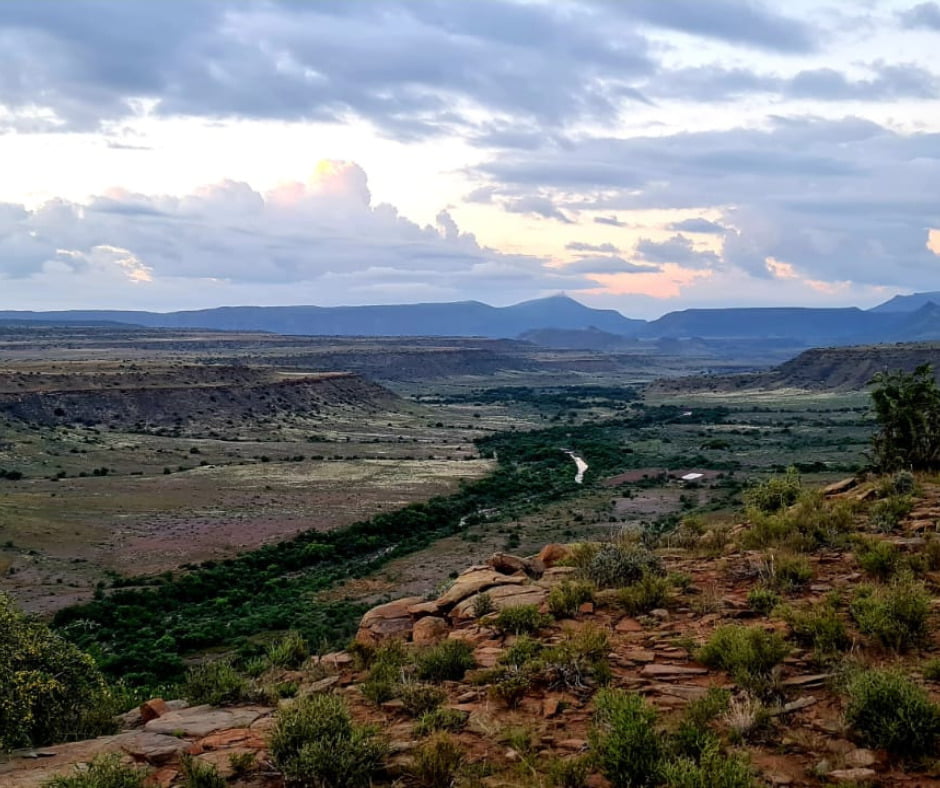
It’s amazing what people miss in the Karoo. And astonishing what a difference it would make to your visit if you knew what you were looking at. It’s not easy to find out though, it’s like a kind of academic secret; you have to plough through wads of articles, papers and notes that make little sense to the layman, and are often contradictory. You may find yourself more bewildered at the end of your search for knowledge than at the beginning.
So we have not attempted to stuff a host of conflicting detail into this article. The Karoo’s geological history is complex and confusing – but what you may glean when you visit this unique area, is that you are looking at some of the oldest places in the history of life on Earth. And that, we think, is a blast.
The most fascinating thing about the Karoo is the antiquity of its geological record. It appears it is an area of land that has remained fairly steady for long periods of time despite vast pieces on either side sliding sneakily away to form other continents and float gently ever further, creating vast oceans that once were not there.
The result is that the Karoo reflects an almost uninterrupted line of life and evolution through the ages, from the Carboniferous Period (approximately 360 million years ago) right through to what we see today – a vast empty basin comprising flat sandy stretches and ubiquitous koppies still evolving in the wind and timeless silence.
When you visit the Karoo, you are looking at literally the world’s only and oldest clock of continual clues to evidence of the development of life on Earth. Its extraordinary geological record has: stamped the outlines of the oldest multi-cellular animals into rocks; revealed a fossil track of dinosaurs from their earliest lumpy ancestors of the Triassic to the more fleet of foot of the Cretaceous epoch.
Following the dinosaurs, the Karoo also presents an almost complete record of more than 80 million years of the ancestry of mammals – along with a canvas of human origins and early achievements. It is difficult to comprehensively discuss the development of life on Earth without referring to this extensive South African fossil record. And here we are, living right on top of it, so to speak, with incredible opportunities to walk through the wonder of this enduring map of history.
So in order to make things reasonably digestible, we have extrapolated some pertinent points to note when you journey through this magical landscape
- This is the only place in the world where an invaluable and extended fossil record of the early evolution of reptilian life is preserved in a single basin.
- The time span of the Karoo extends from around the beginning of the Carboniferous Period (about 360 million years ago) right up to the present dust at your feet.
- Karoo rocks provide an unrivalled window into the late Triassic Period when plant and insect biodiversity began to flourish, close to the time of the origin of dinosaurs, mammals, and possibly flowering plants. With this in mind, the Karoo presents a singular glimpse of reptilian life, especially the mammal-like therapsid reptiles, among whose ranks we can find the ancestors of true mammals.
- At its thickest, the Karoo consists of more than 10,500m (35,000 feet) of rocks. These rocks, deposited over an extensive period from the late Carboniferous to the early Jurassic (180 million years ago), witnessed the immense environmental change from glaciers to desert dunes, and an eventual momentous event culminating in a vast outpouring of volcanic lava.
- Looking back at the late Carboniferous, we would see that the entire area was once covered by continental ice sheets. As an ancient continent of the time, Gondwana – which included present-day Southern Africa – began to drift north, and eventually, the ice sheets melted, giving rise to a large inland sea which supported the earliest reptiles of Gondwana.
- Initially, the last of the glaciers of the time found themselves floating on this vast inland sea until they eventually grounded, scouring the bedrock, leaving behind scratch marks that can still be seen near Barkly West in the Northern Cape and (apparently being of academic bent) in the grounds of the University of KwaZulu-Natal. These traces are important because they provide crucial early evidence in support of continental drift.
- The subduction of the paleo-Pacific Oceanic plate pushing under the Falkland Plateau during the early Permian Period raised a massive range of mountains. The subsequent weight of these mountains caused the continental crust of Southern Africa to sag, and the ensuing basin contributed to the influx of the Karoo Sea.
- Rivers draining from the mountains to the north of the Karoo Sea formed large swampy deltas in which plants flourished. Over millennia, this dense vegetation accumulated as peat, eventually turning into the coal that we merrily mine today.
- It’s perhaps pertinent to remember that none of these changes took place quickly but over millions of years. There was no sudden storm on one day that could be blamed on ‘climate change’ – the changes were gigantic but ponderous and made their long-term marks without consideration for resulting effects on life on Earth.
The Beaufort Rocks
The Beaufort rocks need special mention. They are internationally famous for a rich record of therapsid synapsids (mammal-like reptiles), which mark an intermediary stage in the evolution of mammals from reptiles.
- The most abundant of these herbivores were the dinocephalians (terrible head), so named because of their extraordinary thick-boned skulls probably used for head-butting during territorial fights. With their 3-metre body length, they were the first large animals to live on land.
- Approximately 250 million years ago, at the end of the Permian Period, a massive extinction took place and 95% of all life died. This extraordinary global event can be seen clearly in the Beaufort rocks.
- With time, the Beaufort deposits became more fine-grained once again, probably indicating a recovery of the vegetation in the Karoo, and with that resurgence, the appearance of a wide range of new species, including the dinosaurs, and eventually true mammals during the late Triassic and early Jurassic Periods.
- Then around 180 million years ago, southern Gondwana had the temerity to pass over the Bouvet Hotspot (triple junction of the South American, African and Antarctic plates) – an unfortunate event because it caused the crust under the Karoo to rupture, releasing huge volumes of basaltic lava which proceeded to cover nearly the whole of Southern Africa packaged within the Gondwana continent.
- Interestingly enough, although volcanoes were rare, magma welled up through long crack-like fissures, each surface lava flow between 10 and 20 metres thick. These flows piled up in rapid succession over 2 million years to form a single continuous lava layer that reached kilometres deep.
- This uplifted new surface then heralded a phase of massive erosion, slowly removing these layers bit by bit over another few million years. Once the layer of hard lava was eroded away, softer Karoo sediments over the rest of the basin eroded even faster. However, dolerite sills resisted erosion, protecting the softer shales beneath them – thus creating the numerous iconic, flat-topped ‘koppies’ we see today.
Heuningland: African & Karoo tours to stir the heart and lift the soul
We are proudly South African and have a fervent love of the Great Karoo, its people and its unique vegetation and animals. We are passionate conservationists of nature and would like to share our knowledge acquired through years of travel and touring experience. We are therefore able to offer custom-designed and distinctively different tour options:
- Hiking/camping trails or guided self-driving tours through the ancient landscape of the Karoo.
- Tailor-made safaris to any destination in South Africa, Namibia, Zimbabwe, Zambia, Mozambique, and Botswana.




